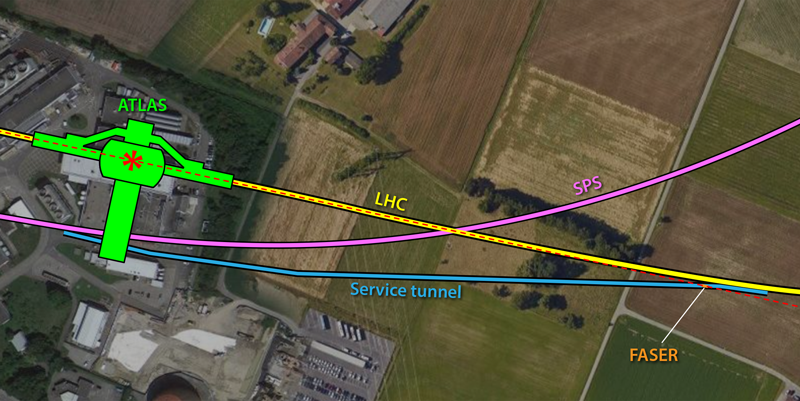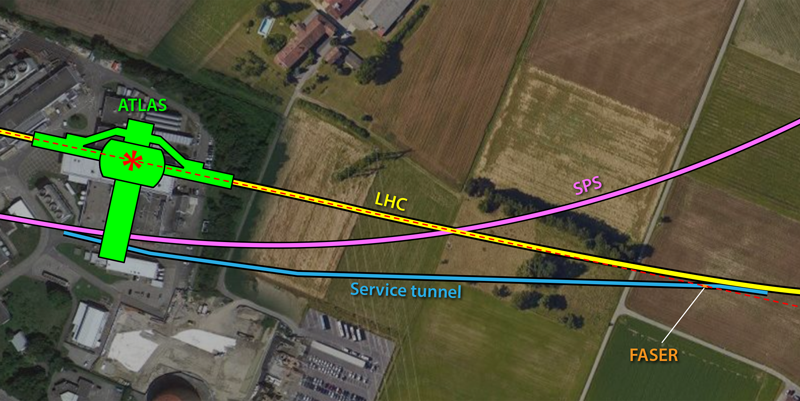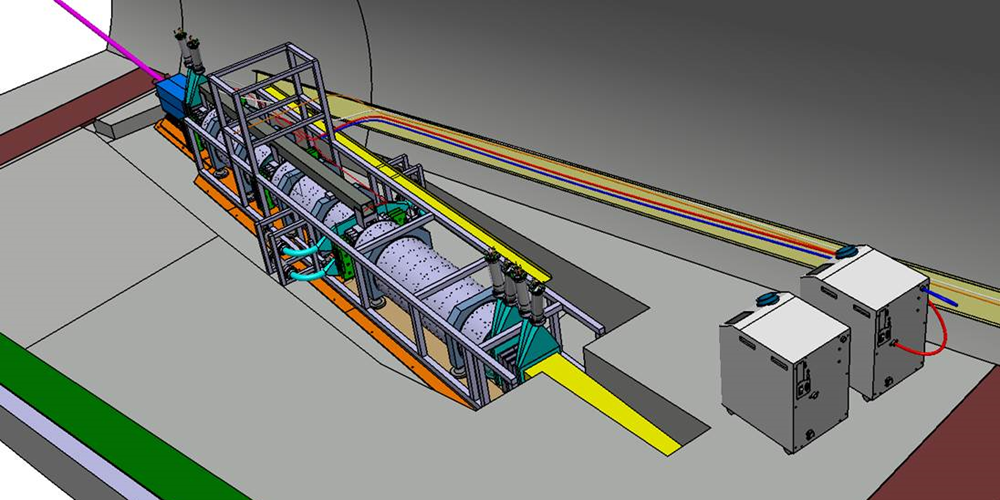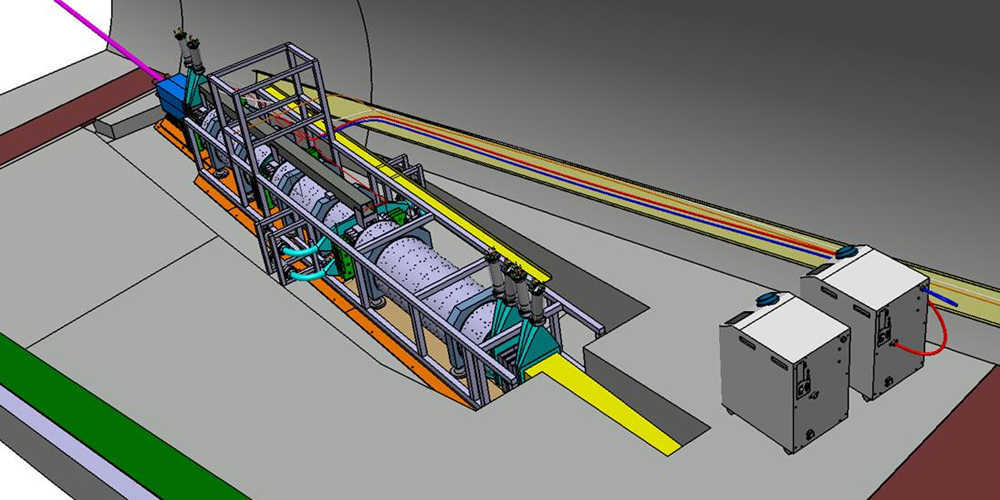The Dawn of Collider Neutrino Physics
Neutrinos are among the most abundant particles in the Universe, but they rarely interact with matter: trillions pass through us every second, but most of us will never have even a single one interact with the matter in our bodies. Nonetheless, scientists can study these particles using high-intensity neutrino sources and detectors that are large enough to overcome the rarity of neutrino interactions. In this way, neutrinos have been observed from the Sun, from cosmic-ray interactions in the atmosphere, from Earth’s interior, from supernovae and other astrophysical objects, and from artificial sources such as nuclear reactors and particle accelerators in which a beam of particles hits a fixed target. But no one had ever detected neutrinos produced in colliding beams. This feat has now been achieved by the Forward Search Experiment (FASER), located at the Large Hadron Collider (LHC) at CERN in Switzerland [1].
As neutral particles, neutrinos cannot be directly observed by detectors of the kind used in particle colliders. Instead, scientists study neutrinos via the particles produced when incoming neutrinos interact with matter: the properties of the incoming neutrinos can be inferred from the measured properties of their interaction products. While these interactions are always rare, their probability increases with neutrino energy. In a particle collider, the highest energy neutrinos are most likely to be produced in a region of the collider where there are no particle detectors. Collider experiments are built to surround the colliding beams with detectors, with only a small central region left empty to allow for the entry and exit of the beams. It is in this empty “forward” region, along the collision axis, that the highest energy neutrinos are most likely to be produced. Additionally, typical collider experiments are very busy environments, with many charged particles emerging from the collision, making it impossible to isolate neutrino events.
FASER is designed and positioned specifically to detect weakly interacting particles such as neutrinos in the forward region of the LHC’s ATLAS experiment. It is located in a separate tunnel about 480 meters from the ATLAS interaction point (IP)—the place where the beams collide—so that it doesn’t interfere with the beams’ trajectories (Fig. 1). Charged particles are deflected away by magnets controlling the LHC beams, and about 100 meters of rock and concrete separate FASER and the ATLAS IP. As a result, only neutral particles that interact with matter through the weak interaction—and that can thus pass through the rock and concrete unimpeded—can travel from the IP to FASER.
When neutrinos interact with matter via a charged current interaction (involving the exchange of a W boson), a charged lepton of the same flavor as the neutrino is produced. For example, a charged-current interaction involving an electron neutrino always produces an electron, while one involving a muon neutrino always produces a muon. The FASER Collaboration’s analysis focuses on identifying muon neutrinos and antineutrinos and thus identifies events in which a muon or antimuon is produced inside a tungsten target at the end of the experiment nearest to the ATLAS IP (Fig. 2). Scintillator-based “veto” detectors, which emit light when charged particles pass through them, select events consistent with a single muon being produced in the target and reject events in which a muon or other charged particle enters from outside the detector. A tracking spectrometer, consisting of silicon microstrips inside a magnetic field, is used to measure the momentum and trajectory of the muon—the analysis requires that the muon have a momentum larger than would be expected for nonsignal events and a trajectory consistent with an origin within the target.
The researchers analyze data taken between July and November 2022. From the thousands of events studied, 153 pass the selection criteria and are identified as being consistent with a muon or antimuon neutrino interaction. Based on simulations and statistical analysis, the team determines that almost all of these events come from true charged-current interactions involving muon or antimuon neutrinos. Only a handful of the events are potentially “background,” defined as nonsignal events that pass the selection criteria—such as events resulting from neutral hadrons that interact in the target or from muons that enter from outside the detector with trajectories that avoid triggering the veto detectors. The final number of neutrino events, including statistical uncertainty and background estimation, is 153 +12−13, which has a significance of 16 standard deviations over a background-only hypothesis. Given that this observation is consistent with expectations from simulations, and that the spatial distribution and properties of these events are consistent with them being neutrino interactions, the experiment provides a definitive first detection of neutrinos from a particle collider. Soon after the observation of FASER’s 153 signal events, another LHC experiment, the Scattering and Neutrino Detector, also reported eight events with large significance, providing additional verification that neutrinos from particle collisions are now being observed at the LHC [2].
Observing particles in a new way is always exciting, but the principal importance of this result is that it opens the door for a future program of neutrino physics measurements at collider experiments. We never know what we might see through a new experimental window like this, but physicists are already thinking about measurements they would like to make and future experiments that could build on the potential demonstrated by this result. A white paper on a proposed LHC research center—the Forward Physics Facility (FPF) [3]—describes a suite of experiments that would include upgraded versions of the detectors used in the FASER Collaboration’s work. The FPF is designed to address a wide range of topics, including searches for hypothetical particles and dark matter, astrophysics, tests of quantum chromodynamics, and neutrino physics.
The neutrino energy range accessible at the LHC has not been directly probed by other experiments and, unlike most artificial neutrino sources, LHC collisions produce all three flavors of neutrino (electron, muon, and tau) in abundance. Comparing measurements of the rate of neutrino interactions and the properties of the observed neutrinos to theoretical models will improve our understanding of the underlying fundamental processes and help us to search for new physics not described by current models. As a single example among many, only a few tau neutrinos have ever been detected, whereas using the next iteration of FASER, the energy spectrum of thousands of tau neutrinos could be measured and compared to theoretical predictions. In some models that include a hypothetical additional Higgs particle, the observed tau neutrino spectrum would have lower energies than predicted by the standard model. Consequently, with the new field of collider neutrino physics heralded by this sample of 153 muon neutrino candidates, many thousands of high-energy neutrinos of all flavors may be observed, which can be used to search for new physics to and extend our understanding of the fundamental forces of nature.
References
- H. Abreu et al. (FASER Collaboration), “First direct observation of collider neutrinos with FASER at the LHC,” Phys. Rev. Lett. 131, 031801 (2023).
- R. Albanese et al. (SND@LHC Collaboration), “Observation of collider muon neutrinos with the SND@LHC experiment,” Phys. Rev. Lett. 131, 031802 (2023).
- J. L. Feng et al., “The forward physics facility at the high-luminosity LHC,” J. Phys. G: Nucl. Part. Phys. 50, 030501 (2023).







